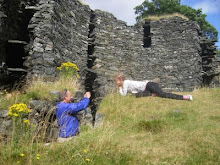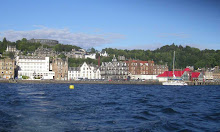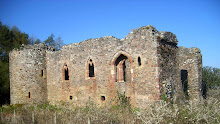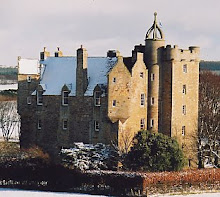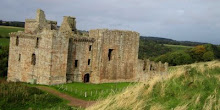The
Scottish Highlands was at one stage a patchwork of clan territories and I’m
drawn to the idea of illuminating this heritage by re-establishing clan lands ‘on
the ground’. Roadside signs announcing which bailiwick lies ahead would add character to our countryside and would also be great for
tourism: members of the Diaspora would enjoy a surge of excitement, certain
that they had arrived ‘home’.
Of
course an agreed date would be needed because clan lands grew and contracted
over the ages. And even then it wouldn’t be straightforward: the process of fixing
the exact location of signs evokes a nice image of red-faced, kilted clan
chiefs, tussling with cromachs to establish where boundaries belong.
Fanciful?
Not entirely. With, so far as I know, no falling out with their neighbours, Clan
Mackay staked out their territory back in 2004 with six "Mackay
Country" signs. The lands are in the far North West and so signs were
placed at Kylesku, Achfary,
Forsinard,
Dalvina and on the A836 road at the Caithness/Sutherland
border.
In
Gaelic the name is rendered as Macaoidh, son of Hugh. They claim descent from
both Somerled and the Celtic royal house, from both of whom they inherited a robust
warrior spirit, much needed in early times as the Earls of Sutherland endeavoured
to encroach on “Mackay Country”.
However
by the 17th century their neighbours – Sinclairs, Sutherlands, MacLeods
and Gunns - were presumably content and gave them relatively little trouble. The Mackays therefore had
to go abroad for a fight: in 1626 Sir Donald Mackay took 3000 Mackays to fight
for the King of Denmark in the Thirty Years' War. And in 1631 Lord Reay, the
clan chief, raised another force for service with Gustavus
Adolphus, King of Sweden; the earliest depiction of the kilt is
assumed to be Mackays in the service of Gustavus Adolphus.
General
Hugh Mackay of Scourie was a professional soldier. He fought the Turks
on behalf of the Republic of Venice (1669), the French on behalf of the Dutch
(1674) and commanded the army that faced the Jacobites at the Battle of
Killiecrankie (1689), dying in the field at the Battle of Steinkirk (1692), in a doomed attack against the French, ordered by William
of Orange (King William III)
During
the Jacobite risings. Mackays were unwaveringly Hanoverian and produced two
independent highland companies to oppose ‘Bonnie Prince Charlie. It was
principally Mackays who won the skirmish at Littleferry near Golspie on 15
April 1746 and captured the Jacobite George Mackenzie, 3rd Earl of
Cromartie at Dunrobin
Castle.
If you venture up to Mackay Country don’t drive past the excellent Strathnaver Museum and find time if you can to walk up to Caisteal Bharraich.
 |
| Caisteal Bharraich |












































